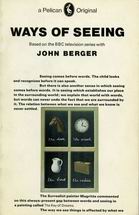

|
|

Ways of Seeing
Berger, John
Publisher: Penguin, London, United KingdomYear Published: 1972 Pages: 170pp ISBN: 0 14 02 1631 6 Dewey: 152.14 Resource Type: Book Cx Number: CX6630 Seeing establishes our place in the surrounding world; we explain that world with words, but words can never undo the fact that we are surrounded by it. Abstract: Ways of Seeing examines the relationship between what we know and what we see. Derived from the BBC television series of the same name with John Berger, this book examines how sight or the act of seeing comes before words or language. Thus, seeing establishes our place within the world and although we use words to describe everything language cannot undo our initial experience of the world through sight. This gap between words and sight is raised in the Surrealist painting Key of Dreams by Magritte. According to the editors, the form of the book is as important as its content. The book consists of seven numbered essays, which can be read in any order: four essays use words and images, while the remaining three essays use only images. These three pictorial images are about the ways of seeing women and the various contradictory aspects of the tradition of oil painting. Both genres of essays are intended to raise a similar amount of questions to the reader and begin a process of questioning. The pictorial essays do not include information about the reproduced images so as to not interfere with the author's intended message with unrelated information. However, a list of information about these images is provided at the back of the book. Specific topics which are included within the written essays include how the image is defined as a relic or text of the past with historical power that surpasses the potential of literature. The second written essay asks how a woman's presence or appearance defines her attitude about herself and in turn what can be done to her by others. This is combined with an internalized awareness that as a woman, she is constantly being viewed by spectators. Thus, this essays discusses how a woman is simultaneously a surveyor of herself due to the social rules impressed upon her sex by society: how she is viewed by others, especially men, determines her success. The third essay discusses how the analogy of possessing and the way of seeing is incorporated into oil painting. The authors track the development of the tradition of oil painting and how it influences our ways of seeing things and cultural assumptions. The fourth non-pictorial essay examines how publicity images impact us. The authors demonstrate how we as humans are static because we take in these images throughout the day, which affect us in the future. [Abstract by Amanpreet Dhami] Excerpts: We only see what we look at. To look is an act of choice. As a result of this act, what we see is brought within our reach - though not necessarily within arm's reach. ... The past is never there waiting to be discovered, to be recognized for exactly what it is. History always constitutes the relation between a present and its past. Consequently fear of the present leads to mystification of the past. The past is not for living in; it is a well of conclusions from which we draw in order to act. ... Mystification has little to do with the vocabulary used. Mystification is the process of explaining away what might otherwise be evident. ... A people or a class which is cut off from its own past is far less free to choose and to act as a people or class than one that has been able to situate itself in history. ... It is true that in publicity one brand of manufacture, one firm, competes with another; but it is also true that every publicity image confirms and enhances every other. Publicity is not merely as assembly of competing message: it is a language it itself which is always being used to make the same general proposal. Within publicity, choices are offered between this cream and that cream, that car and this car, but publicity as a system only makes a single proposal. It proposes to each of us that we transform ourselves, or our lives, by buying something more. This more, it proposes, will make us in some way richer - even though we will be poorer by having spent out money. ... Publicity has another important social function. The fact that this function has not been planned as a purpose by those who make and use publicity in no ways lessens its significance. Publicity turns consumption into a substitute for democracy. The choice of what one eats (or wears or drives) takes the place of significant political choice. Publicity helps to mask and compensate for all that is undemocratic within society. And it also masks what is happening in the rest of the world. Publicity adds up to a kind of philosophical system. It explains everything in its own terms. It interprets the world. Subject Headings |